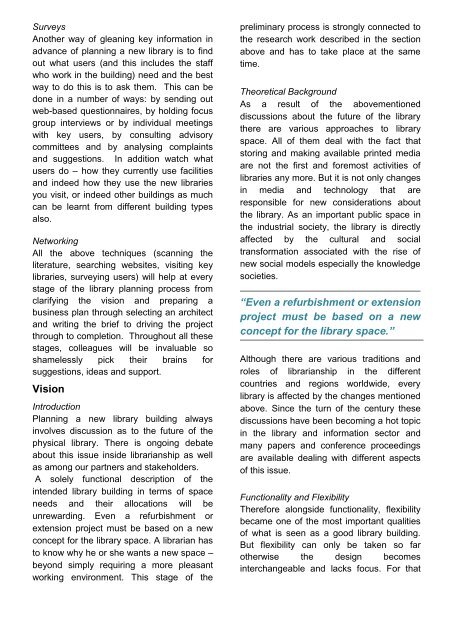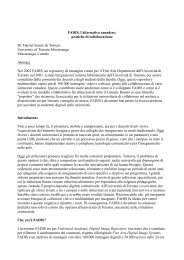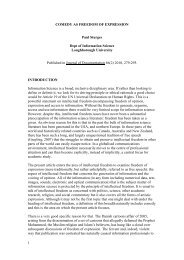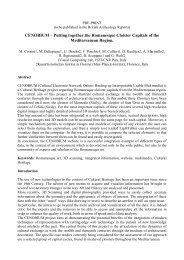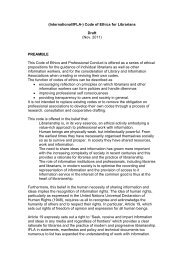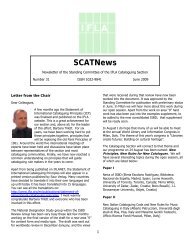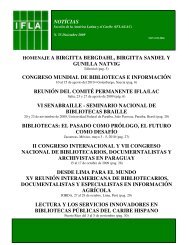Library Buildings and Equipment Section Key Issues in ... - IFLA
Library Buildings and Equipment Section Key Issues in ... - IFLA
Library Buildings and Equipment Section Key Issues in ... - IFLA
You also want an ePaper? Increase the reach of your titles
YUMPU automatically turns print PDFs into web optimized ePapers that Google loves.
Surveys<br />
Another way of glean<strong>in</strong>g key <strong>in</strong>formation <strong>in</strong><br />
advance of plann<strong>in</strong>g a new library is to f<strong>in</strong>d<br />
out what users (<strong>and</strong> this <strong>in</strong>cludes the staff<br />
who work <strong>in</strong> the build<strong>in</strong>g) need <strong>and</strong> the best<br />
way to do this is to ask them. This can be<br />
done <strong>in</strong> a number of ways: by send<strong>in</strong>g out<br />
web-based questionnaires, by hold<strong>in</strong>g focus<br />
group <strong>in</strong>terviews or by <strong>in</strong>dividual meet<strong>in</strong>gs<br />
with key users, by consult<strong>in</strong>g advisory<br />
committees <strong>and</strong> by analys<strong>in</strong>g compla<strong>in</strong>ts<br />
<strong>and</strong> suggestions. In addition watch what<br />
users do – how they currently use facilities<br />
<strong>and</strong> <strong>in</strong>deed how they use the new libraries<br />
you visit, or <strong>in</strong>deed other build<strong>in</strong>gs as much<br />
can be learnt from different build<strong>in</strong>g types<br />
also.<br />
Network<strong>in</strong>g<br />
All the above techniques (scann<strong>in</strong>g the<br />
literature, search<strong>in</strong>g websites, visit<strong>in</strong>g key<br />
libraries, survey<strong>in</strong>g users) will help at every<br />
stage of the library plann<strong>in</strong>g process from<br />
clarify<strong>in</strong>g the vision <strong>and</strong> prepar<strong>in</strong>g a<br />
bus<strong>in</strong>ess plan through select<strong>in</strong>g an architect<br />
<strong>and</strong> writ<strong>in</strong>g the brief to driv<strong>in</strong>g the project<br />
through to completion. Throughout all these<br />
stages, colleagues will be <strong>in</strong>valuable so<br />
shamelessly pick their bra<strong>in</strong>s for<br />
suggestions, ideas <strong>and</strong> support.<br />
Vision<br />
Introduction<br />
Plann<strong>in</strong>g a new library build<strong>in</strong>g always<br />
<strong>in</strong>volves discussion as to the future of the<br />
physical library. There is ongo<strong>in</strong>g debate<br />
about this issue <strong>in</strong>side librarianship as well<br />
as among our partners <strong>and</strong> stakeholders.<br />
A solely functional description of the<br />
<strong>in</strong>tended library build<strong>in</strong>g <strong>in</strong> terms of space<br />
needs <strong>and</strong> their allocations will be<br />
unreward<strong>in</strong>g. Even a refurbishment or<br />
extension project must be based on a new<br />
concept for the library space. A librarian has<br />
to know why he or she wants a new space –<br />
beyond simply requir<strong>in</strong>g a more pleasant<br />
work<strong>in</strong>g environment. This stage of the<br />
prelim<strong>in</strong>ary process is strongly connected to<br />
the research work described <strong>in</strong> the section<br />
above <strong>and</strong> has to take place at the same<br />
time.<br />
Theoretical Background<br />
As a result of the abovementioned<br />
discussions about the future of the library<br />
there are various approaches to library<br />
space. All of them deal with the fact that<br />
stor<strong>in</strong>g <strong>and</strong> mak<strong>in</strong>g available pr<strong>in</strong>ted media<br />
are not the first <strong>and</strong> foremost activities of<br />
libraries any more. But it is not only changes<br />
<strong>in</strong> media <strong>and</strong> technology that are<br />
responsible for new considerations about<br />
the library. As an important public space <strong>in</strong><br />
the <strong>in</strong>dustrial society, the library is directly<br />
affected by the cultural <strong>and</strong> social<br />
transformation associated with the rise of<br />
new social models especially the knowledge<br />
societies.<br />
“Even a refurbishment or extension<br />
project must be based on a new<br />
concept for the library space.”<br />
Although there are various traditions <strong>and</strong><br />
roles of librarianship <strong>in</strong> the different<br />
countries <strong>and</strong> regions worldwide, every<br />
library is affected by the changes mentioned<br />
above. S<strong>in</strong>ce the turn of the century these<br />
discussions have been becom<strong>in</strong>g a hot topic<br />
<strong>in</strong> the library <strong>and</strong> <strong>in</strong>formation sector <strong>and</strong><br />
many papers <strong>and</strong> conference proceed<strong>in</strong>gs<br />
are available deal<strong>in</strong>g with different aspects<br />
of this issue.<br />
Functionality <strong>and</strong> Flexibility<br />
Therefore alongside functionality, flexibility<br />
became one of the most important qualities<br />
of what is seen as a good library build<strong>in</strong>g.<br />
But flexibility can only be taken so far<br />
otherwise the design becomes<br />
<strong>in</strong>terchangeable <strong>and</strong> lacks focus. For that


